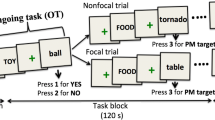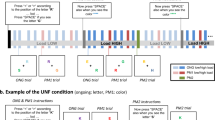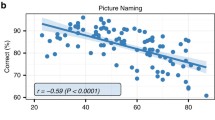Abstract
Prospective memory (PM) refers to the ability to remember to execute an intention at the appropriate moment in the future, which can be performed either at the appearance of an event (event-based, EBPM) or after a certain amount of time (time-based, TBPM). PM is generally impaired during aging but the cerebral substrates of this decline have been little investigated. Using functional Magnetic Resonance Imaging (fMRI), we investigated the neural bases of PM in 20 young and 20 healthy older adults. They were proposed a task of semantic categorisation of pictures (ongoing task). For some blocks, participants only had to perform this ongoing task while, for others, a PM instruction was added. In this case, a supplementary answer in response to a specific colour of border for EBPM or at specific time intervals for TBPM was expected. PM, and more particularly TBPM, declined in older adults. For both PM conditions, older adults recruited additional brain areas, but also showed reduced deactivations of other regions. These results are discussed in light of models of the aging brain.



Similar content being viewed by others
References
Baltes, P. B., & Lindenberger, U. (1997). Emergence of a powerful connection between sensory and cognitive functions across the adult life span: a new window to the study of cognitive aging? Psychology and Aging, 12(1), 12–21.
Barban, F., Carlesimo, G. A., Macaluso, E., Caltagirone, C., & Costa, A. (2013). Functional brain activity within the medial and lateral portion of BA10 during a prospective memory task. Behavioural Neurology, 26(3), 207–209.
Beck, S. M., Ruge, H., Walser, M., & Goschke, T. (2014). The functional neuroanatomy of spontaneous retrieval and strategic monitoring of delayed intentions. Neuropsychologia, 52, 37–50.
Benoit, R. G., Gilbert, S. J., Frith, C. D., & Burgess, P. W. (2012). Rostral prefrontal cortex and the focus of attention in prospective memory. Cerebral cortex (New York, N.Y.: 1991), 22(8), 1876–1886.
Burgess, P. W., Quayle, A., & Frith, C. D. (2001). Brain regions involved in prospective memory as determined by positron emission tomography. Neuropsychologia, 39(6), 545–555.
Burgess, P. W., Scott, S. K., & Frith, C. D. (2003). The role of the rostral frontal cortex (area 10) in prospective memory: a lateral versus medial dissociation. Neuropsychologia, 41(8), 906–918.
Burgess, P. W., Dumontheil, I., & Gilbert, S. J. (2007). The gateway hypothesis of rostral prefrontal cortex (area 10) function. Trends in Cognitive Sciences, 11(7), 290–298.
Burgess, P. W., Gonen-Yaacovi, G., & Volle, E. (2011). Functional neuroimaging studies of prospective memory: what have we learnt so far? Neuropsychologia, 49(8), 2246–2257.
Cabeza, R., Anderson, N. D., Locantore, J. K., & McIntosh, A. R. (2002). Aging Gracefully: Compensatory Brain Activity in High-Performing Older Adults. NeuroImage, 17(3), 1394–1402.
Cona, G., Arcara, G., Tarantino, V., & Silvia Bisiacchi, P. (2012). Age-related differences in the neural correlates of remembering time-based intentions. Neuropsychologia, 50(11), 2962–2704.
Cona, G., Scarpazza, C., Sartori, G., Moscovitch, M., & Bisiacchi, P. S. (2015). Neural bases of prospective memory: a meta-analysis and the “attention to delayed intention” (AtoDI) model. Neuroscience and Biobehavioral Reviews, 52, 21–37.
Craik, F. I. M. (1986). A functional account of age differences in memory. In F. Lix & H. Hagendorf (Eds.), Human memory and cognitive capabilities: Mechanisms and performances (pp. 409–422). Amsterdam: Elsevier Science.
Davis, S. W., Dennis, N. A., Daselaar, S. M., Fleck, M. S., & Cabeza, R. (2008). Que PASA? The Posterior-Anterior Shift in Aging. Cerebral Cortex, 18(5), 1201–1209.
Den Ouden, H. E. M., Frith, U., Frith, C., & Blakemore, S.-J. (2005). Thinking about intentions. NeuroImage, 28(4), 787–796.
Einstein, G. O., & McDaniel, M. A. (1990). Normal aging and prospective memory. Journal of Experimental Psychology. Learning, Memory, and Cognition, 16(4), 717–726.
Einstein, G. O., McDaniel, M. A., Richardson, S. L., Guynn, M. J., & Cunfer, A. R. (1995). Aging and prospective memory: examining the influences of self-initiated retrieval processes. Journal of Experimental Psychology. Learning, Memory, and Cognition, 21(4), 996–1007.
Folstein, M. F., Folstein, S. E., & McHugh, P. R. (1975). “mini-mental state”. A practical method for grading the cognitive state of patients for the clinician. Journal of Psychiatric Research, 12(3), 189–198.
Gao, J., Cheung, R. T. F., Chan, Y.-S., Chu, L.-W., Mak, H. K. F., & Lee, T. M. C. (2014). The relevance of short-range fibers to cognitive efficiency and brain activation in aging and dementia. PloS One, 9(4), e90307.
Gonneaud, J., Kalpouzos, G., Bon, L., Viader, F., Eustache, F., & Desgranges, B. (2011). Distinct and shared cognitive functions mediate event- and time-based prospective memory impairment in normal ageing. Memory (Hove, England), 19(4), 360–377.
Gonneaud, J., Rauchs, G., Groussard, M., Landeau, B., Mézenge, F., de La Sayette, V., et al. (2014). How do we process event-based and time-based intentions in the brain? An fMRI study of prospective memory in healthy individuals. Human Brain Mapping, 35(7), 3066–3082.
Guynn, M. J., McDaniel, M. A., & Einstein, G. O. (1998). Prospective memory: when reminders fail. Memory & Cognition, 26(2), 287–298.
Hafkemeijer, A., van der Grond, J., & Rombouts, S. A. R. B. (2012). Imaging the default mode network in aging and dementia. Biochimica et Biophysica Acta, 1822(3), 431–441.
Henry, J. D., MacLeod, M. S., Phillips, L. H., & Crawford, J. R. (2004). A meta-analytic review of prospective memory and aging. Psychology and Aging, 19(1), 27–39.
Ihle, A., Hering, A., Mahy, C. E. V., Bisiacchi, P. S., & Kliegel, M. (2013). Adult age differences, response management, and cue focality in event-based prospective memory: a meta-analysis on the role of task order specificity. Psychology and Aging, 28(3), 714–720.
Kalpouzos, G., Chételat, G., Baron, J.-C., Landeau, B., Mevel, K., Godeau, C., et al. (2009). Voxel-based mapping of brain gray matter volume and glucose metabolism profiles in normal aging. Neurobiology of Aging, 30(1), 112–124.
Khan, A., Sharma, N. K., & Dixit, S. (2008). Cognitive load and task condition in event- and time-based prospective memory: an experimental investigation. The Journal of Psychology, 142(5), 517–531.
Kliegel, M., Ramuschkat, G., & Martin, M. (2003). [Executive functions and prospective memory performance in old age: an analysis of event-based and time-based prospective memory]. Zeitschrift Für Gerontologie Und Geriatrie: Organ Der Deutschen Gesellschaft Für Gerontologie Und Geriatrie, 36(1), 35–41.
Lustig, C., Snyder, A. Z., Bhakta, M., O’Brien, K. C., McAvoy, M., Raichle, M. E., et al. (2003). Functional deactivations: change with age and dementia of the Alzheimer type. Proceedings of the National Academy of Sciences of the United States of America, 100(24), 14504–14509.
Mäntylä, T., Missier, F. D., & Nilsson, L.-G. (2009). Age differences in multiple outcome measures of time-based prospective memory. Neuropsychology, Development, and Cognition. Section B, Aging, Neuropsychology and Cognition, 16(6), 708–720.
Martin, M., Kliegel, M., & McDaniel, M. A. (2003). The involvement of executive functions in prospective memory performance of adults. International Journal of Psychology, 38(4), 195–206.
Mattis, S. (1976). Mental status examination for organic mental syndrome in the elderly patient. In L. Bellack & T. E. Karasu (Eds.), Geriatric psychiatry (pp. 77–121). New York: Grune & Stratton.
Mattli, F., Zöllig, J., & West, R. (2011). Age-related differences in the temporal dynamics of prospective memory retrieval: a lifespan approach. Neuropsychologia, 49(12), 3494–3504.
McDaniel, M. A., & Einstein, G. O. (2000). Strategic and automatic processes in prospective memory retrieval: a multiprocess framework. Applied Cognitive Psychology, 14(7), S127–S144.
McDaniel, M. A., & Einstein, G. O. (2007). Prospective memory: An overview and synthesis of an emerging field. Thousand Oaks: Sage Publications.
McDaniel, M. A., & Einstein, G. O. (2011). The neuropsychology of prospective memory in normal aging: a componential approach. Neuropsychologia, 49(8), 2147–2155.
Mevel, K., Chételat, G., Eustache, F., & Desgranges, B. (2011). The default mode network in healthy aging and Alzheimer’s disease. International Journal of Alzheimer's Disease, 2011, 535816.
Momennejad, I., & Haynes, J.-D. (2012). Human anterior prefrontal cortex encodes the “what” and “when” of future intentions. NeuroImage, 61(1), 139–148.
Occhionero, M., Esposito, M. J., Cicogna, P. C., & Nigro, G. (2010). The effects of ongoing activity on time estimation in prospective remembering. Applied Cognitive Psychology, 24(6), 774–791.
Oksanen, K. M., Waldum, E. R., McDaniel, M. A., & Braver, T. S. (2014). Neural mechanisms of time-based prospective memory: evidence for transient monitoring. PloS One, 9(3), e92123.
Okuda, J., Fujii, T., Ohtake, H., Tsukiura, T., Yamadori, A., Frith, C. D., & Burgess, P. W. (2007). Differential involvement of regions of rostral prefrontal cortex (Brodmann area 10) in time- and event-based prospective memory. International Journal of Psychophysiology: Official Journal of the International Organization of Psychophysiology, 64(3), 233–246.
Oldfield, R. C. (1971). The assessment and analysis of handedness: the Edinburgh inventory. Neuropsychologia, 9(1), 97–113.
Park, D. C., Hertzog, C., Kidder, D. P., Morrell, R. W., & Mayhorn, C. B. (1997). Effect of age on event-based and time-based prospective memory. Psychology and Aging, 12(2), 314–327.
Peira, N., Ziaei, M., & Persson, J. (2016). Age differences in brain systems supporting transient and sustained processes involved in prospective memory and working memory. NeuroImage, 125, 745–755.
Persson, J., Lustig, C., Nelson, J. K., & Reuter-Lorenz, P. A. (2007). Age differences in deactivation: a link to cognitive control? Journal of Cognitive Neuroscience, 19(6), 1021–1032.
Prakash, R. S., Heo, S., Voss, M. W., Patterson, B., & Kramer, A. F. (2012). Age-related differences in cortical recruitment and suppression: implications for cognitive performance. Behavioural Brain Research, 230(1), 192–200.
Reuter-Lorenz, P. A. (2002). New visions of the aging mind and brain. Trends in Cognitive Sciences, 6(9), 394–400.
Reuter-Lorenz, P. A., & Cappell, K. A. (2008). Neurocognitive aging and the compensation hypothesis. Current Directions in Psychological Science, 17(3), 177–182.
Reuter-Lorenz, P. A., & Lustig, C. (2005). Brain aging: reorganizing discoveries about the aging mind. Current Opinion in Neurobiology, 15(2), 245–251.
Reuter-Lorenz, P. A., & Park, D. C. (2010). Human neuroscience and the aging mind: a new look at old problems. The Journals of Gerontology. Series B, Psychological Sciences and Social Sciences, 65(4), 405–415.
Reynolds, J. R., West, R., & Braver, T. (2009). Distinct neural circuits support transient and sustained processes in prospective memory and working memory. Cerebral Cortex (New York, N.Y.: 1991), 19(5), 1208–1221.
Rusted, J., Ruest, T., & Gray, M. A. (2011). Acute effects of nicotine administration during prospective memory, an event related fMRI study. Neuropsychologia, 49(9), 2362–2368.
Simons, J. S., Schölvinck, M. L., Gilbert, S. J., Frith, C. D., & Burgess, P. W. (2006). Differential components of prospective memory? Evidence from fMRI. Neuropsychologia, 44(8), 1388–1397.
Villain, N., Landeau, B., Groussard, M., Mevel, K., Fouquet, M., Dayan, J., et al. (2010). A simple way to improve anatomical mapping of functional brain imaging. Journal of neuroimaging: official journal of the American Society of Neuroimaging, 20(4), 324–333.
West, R. (2011). The temporal dynamics of prospective memory: a review of the ERP and prospective memory literature. Neuropsychologia, 49(14), 3795–3800.
West, R., & Bowry, R. (2005). Effects of aging and working memory demands on prospective memory. Psychophysiology, 42(6), 698–712.
Acknowledgments
The authors would like to thank F. Lamberton for his help in the fMRI sequences, J. Chavant, J. Dayan, C. Lebouleux, M.H. Noel, M.C. Onfroy, A. Quillard and C. Schupp for data acquisition and recruitment of participants.
Author information
Authors and Affiliations
Corresponding author
Ethics declarations
Conflict of interest
The authors declare that they have no conflict of interest.
Ethical approval
All procedures performed in studies involving human participants were in accordance with the ethical standards of the institutional and/or national research committee and with the 1964 Helsinki declaration and its later amendments or comparable ethical standards.
Informed consent
Informed consent was obtained from all individual participants included in the study.
Fundings
This work was supported by the Association France-Alzheimer and the French Ministère de l’Enseignement Supérieur et de la Recherche.
Rights and permissions
About this article
Cite this article
Gonneaud, J., Lecouvey, G., Groussard, M. et al. Functional dedifferentiation and reduced task-related deactivations underlie the age-related decline of prospective memory. Brain Imaging and Behavior 11, 1873–1884 (2017). https://doi.org/10.1007/s11682-016-9661-z
Published:
Issue Date:
DOI: https://doi.org/10.1007/s11682-016-9661-z




